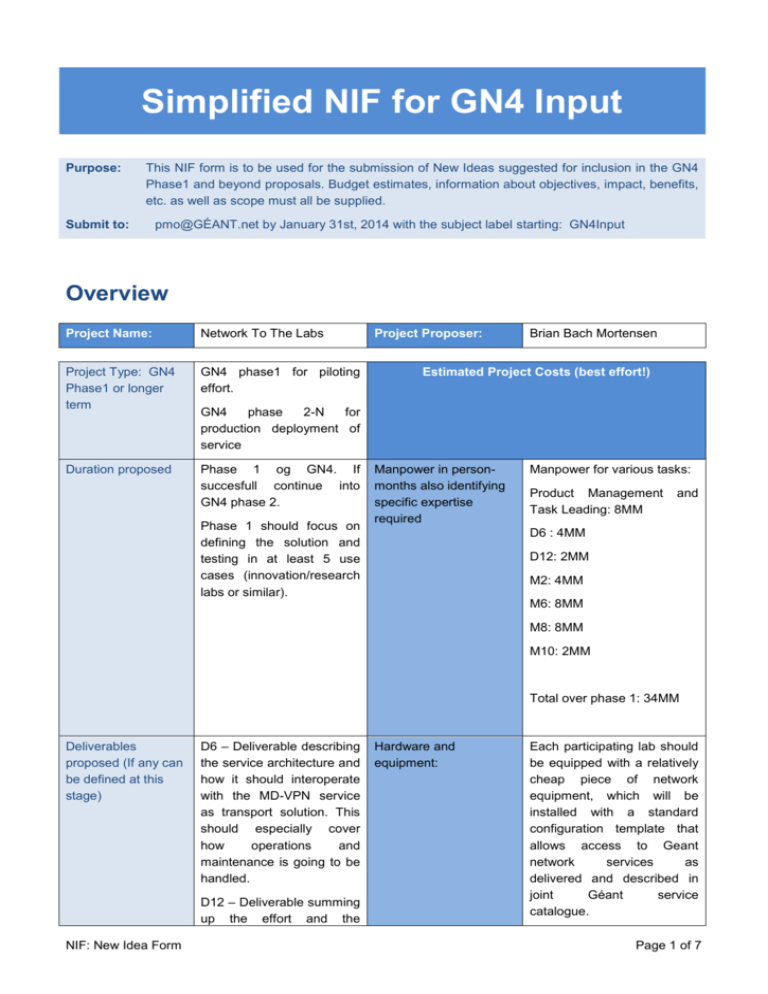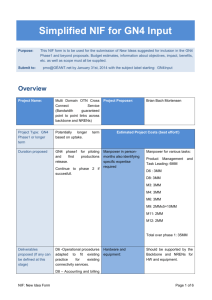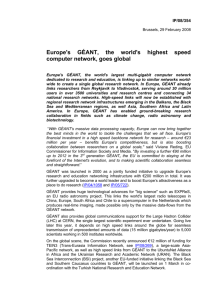Network-to-the-Lab
advertisement

Simplified NIF for GN4 Input Purpose: This NIF form is to be used for the submission of New Ideas suggested for inclusion in the GN4 Phase1 and beyond proposals. Budget estimates, information about objectives, impact, benefits, etc. as well as scope must all be supplied. Submit to: pmo@GÉANT.net by January 31st, 2014 with the subject label starting: GN4Input Overview Project Name: Network To The Labs Project Type: GN4 Phase1 or longer term GN4 phase1 for piloting effort. Duration proposed Phase 1 og GN4. If succesfull continue into GN4 phase 2. Project Proposer: Brian Bach Mortensen Estimated Project Costs (best effort!) GN4 phase 2-N for production deployment of service Phase 1 should focus on defining the solution and testing in at least 5 use cases (innovation/research labs or similar). Manpower in personmonths also identifying specific expertise required Manpower for various tasks: Product Management Task Leading: 8MM and D6 : 4MM D12: 2MM M2: 4MM M6: 8MM M8: 8MM M10: 2MM Total over phase 1: 34MM Deliverables proposed (If any can be defined at this stage) D6 – Deliverable describing the service architecture and how it should interoperate with the MD-VPN service as transport solution. This should especially cover how operations and maintenance is going to be handled. D12 – Deliverable summing up the effort and the NIF: New Idea Form Hardware and equipment: Each participating lab should be equipped with a relatively cheap piece of network equipment, which will be installed with a standard configuration template that allows access to Geant network services as delivered and described in joint Géant service catalogue. Page 1 of 7 achieved results or lack of. Milestones proposed (If any can be defined at this stage) M2 – Define what functions are needed by the CPE boxes in order to connect and manage via the the Geant connectivity services. Other costs Team meetings and travel to use cases: 30000euro Equipment cost: 10000euro M6 – Testing and validation of different hardware equipment should be completed. The outcome should be selction of one model that the project will use for delivering NTTL service. M8 – Operations and maintenance work flow should be defined. A standard configuration template should be defined and tested, enabling access and control of service delivered at the Labs are controllable from Geant side. M10 – 5 use cases should be identified and put in pilot production to access the concept and the possibility to carry further on in the GN4 project phase2. 1 Background and Reasoning Provide background information and the context of the project. Explain the reason for the project. What do you want to be different? What do you hope to improve? Why is the project needed? This should be the reason for the project, not the solution. Research and innovation labs are largely scattered in the European area. These labs are often located and connected through campus/university networks, which again is connected to regional networks and then finally NREN networks. The above mentioned labs may both be productions labs that need to transport data in a virtual private network towards one or more predefined network locations. Other labs may be focussed more on the research and education aspect of networking and will most likely need to connect to other network labs for NIF: New Idea Form Page 2 of 7 the sake of doing experimental network research. In order to lighten the access to different network services the aim of this project is to provide a simple way of connecting the above mentioned labs to the network service cloud that the Geant network service activities (e.g. current GN3plus SA3) is providing. The main idea in this project is to lend labs a piece of network equipment that connects to the MD-VPN network cloud possibly through a simple VLAN tunnel or similar. This tunnel may stretch both campus/and regional networks if they don’t participate in the MD-VPN network service. The network equipment in the lab will be paid, maintained and co-branded by the Géant project. The network equipment has to be configured with a pre defined configuration template in order to ensure fast, reliable and scalable roll out of network equipment. By providing a standardised solution in the labs that supports multiple network services and termination points, Geant will be able to provided fast and flexible network services directly to end users in a collaboration with partners from campus/regional/NREN area. In order to participate in the project a lab has to document that is has “legimate” intentions with the equipment. Furthermore, it should document that it is able to get a network tunnel connection back to the (nearest) Géant service point with support from local campus and regional network operators. The NTTL equipment may serve a number of different network services as indicated below: L3VPNs L2VPN P2P L2VPN MP2MP (VPLS) BoD (Bandwidth guaranteed and reservation based L2 P2P connection) Furthermore it may be used to backhaul traffic to SDN (Software Defined Networks) and NaaS (Network as a Service) network platforms existing in the Géant project. The BoD service effort should be migrated with the MD-VPN service providing prioritised network capacity as needed and available by the users. The status and performance of the CPE equipment should be monitored by a central monitoring instance. These data should be fully available to NOC and eduPert members for validation and service assurance purposes. Furthermore, lab users should be able to monitor simple statistics from this centralised instance using credential that can be authenticated with the eduGain service and software components already existing in GN3plus. For GN4 phase 2 a more complete service catalogue portal could be produced offering a wider range of selectable service based on user requirements. The following figure illustrate the concept that the NTTL project will potentially enable for lab users: Device that might be used to deliver the service at the lab are Juniper SRX100 Juniper ACX100 NIF: New Idea Form Page 3 of 7 NIF: New Idea Form Page 4 of 7 Objectives, Impact and Benefits 2 Provide one or more bullet points to briefly describe the primary objective(s) of the project in terms of the desired outcomes. This should be expressed in the form: ‘To ensure…’, ‘To implement…’, 'To service...', 'To improve...', 'To innovate...', 'To optimize...', 'To save...', etc. For each objective mention the benefits to identified stakeholders (e.g. end-users, NRENs, large international research projects, industrial research partners, high level education, etc.) should be mentioned. A description of the expected overall impact must also be provided. To service research and innovation labs in the European region with network services as per user requests To deliver private and dedicated network capacity to labs as agreed with the lab and in coordination with local network adminstrators (From NREN edge to labs edge) To identify performance issues and help users to mitigate both in local networks and NREN networks, done in collaboration with local NOCs and the eduPert team. To establish private network tunnels all the way to the labs and compute centers ensuring high troughput and avoding firewall performance degradation issues. The service may also be applied as a so called “Science DMZ” solution where the local CPE equipment is configured as simple blocking router based on source IP and ports, should there be a need for that. Scope 3 Describe the areas expected to be covered or impacted by the proposed activity, such as organisational areas, systems, processes, resources.. i.e. what is ‘in scope’. This is not a list of what will be done but identifying the services, areas or what, will be affected. Also please enumerate specific items which although they could perhaps be related are intentionally not addressed by your proposal ("Out of Scope"). 3.1 In Scope Outreach to potential users in coordination with joint account management team Definition of criterias that CPE boxes must support Test and validation of CPE boxes Definition of service architecture in accordance with MD-VPN service cloud Coordination with user labs and university/regional network operators. 3.2 Out of Scope Defining new network services between NRENs. NIF: New Idea Form Page 5 of 7 General Information 4 Outline any potential issues, risks, dependencies, assumptions, constraints and limitations or any other points that may be useful to help assess the proposal. Potentially there is a risk that networks adminstrators in regional and campus may oppose to the idea of bringing the Géant network services closer to the user. In order to reduce this risk we need the potential users to demonstrate that the “trunking” of traffic back to the Géant services is achievable. This way of delivering services have been tested in the NREN community before with succes but not as part of a multi domain effort. There is a risk that network operators feel they are not represented as delivering the service to the users. To migigate this risk the service should be co-branded between project and the local/regional network operators. This (technical) approach is widely adopted in the commercial world and has proved to be a succesfull business model. There is no identications that a similar service should not be feasible in the Geant project if the prerequisites are met as described above.. NIF: New Idea Form Page 6 of 7 NIF: New Idea Form Page 7 of 7









